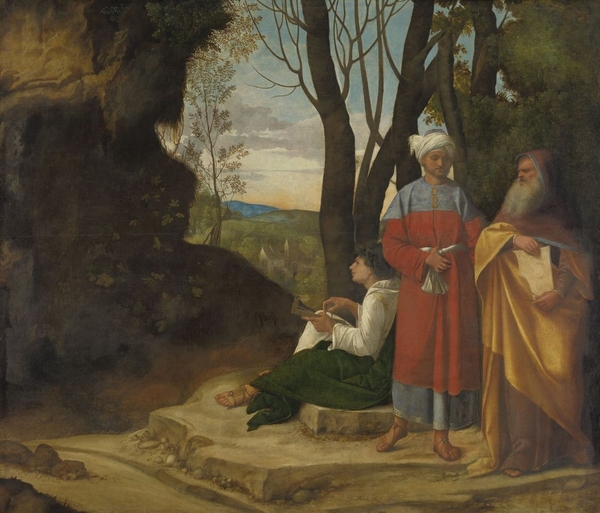New York
When the Frick Collection moved temporarily into the Brutalist Breuer building on Madison Avenue in 2021—while its Beaux-Arts Fifth Avenue mansion closed for expansion and renovation—many comments centered on the placement of its most celebrated possession, Giovanni Bellini's masterpiece "St. Francis in the Desert" (c. 1475-80). Hung in a small gallery by itself, lower and closer to viewers, minus the distracting trappings of its opulent permanent home, and with light streaming in through a trapezoidal window from the same direction as that in the painting, the picture seemed to be perfectly displayed in splendid isolation.
Turns out, those ideal conditions could be even better—as they are now. "St. Francis" has been reunited for the first time in some 400 years with Giorgione's "The Three Philosophers" (c. 1508-09), which scholars believe was created in response to the Bellini. A special exhibition—"Bellini and Giorgione in the House of Taddeo Contarini"—features just the two works, which once hung in the palazzo of that prominent Venetian (though not, as far as is known, together), but have journeyed apart since at least 1636. The Giorgione passed through a few hands in Italy and Britain before joining the Austrian imperial collection and eventually becoming a foundational holding of the Kunsthistorisches Museum in Vienna. The Bellini was owned by at least 20 collectors and dealers before Henry Clay Frick bought it in 1915.
 St. Francis |
For a time in the 1490s, Giorgione was Bellini's student, and as the Frick's chief curator, Xavier F. Salomon, writes in the catalog for this duo exhibition, "the painting by Giorgione could not have been conceived without the example of the Bellini."
 The Three Philosophers |
The two paintings, however, offer different world views. Bellini immerses viewers in endless, eloquent details. The sandals beside the cave, the skull, the closed book on the lectern, and the visitor's bell on the trellis delineate the saint's life of prayer and meditation. In the landscape, the rocks and trees, the rabbit, the heron, the shepherd, the wispy clouds, the bridge to the walled city in the distance and, farther off, the mountain-top enclave, depict the earthly world. St. Francis—gazing toward heaven, with his outstretched hands revealing the stigmata that sealed his closeness to Christ—marvels at this divine miracle bestowed on humanity.
Nearly two generations younger than Bellini, Giorgione created a cryptic painting that has always puzzled even the experts. Art historians have suggested that the men are the three Magi or representations of the three Abrahamic religions (theories now roundly dismissed); the three ages of man (unconvincing); and the ancient Greek philosopher Pythagoras sitting near his teachers, Pherecydes and Thales (the most widely accepted suggestion nowadays). They, like St. Francis, are contemplating the mysteries of the universe, but Giorgione's philosophers are seeking knowledge through secular science, not fathoming it through the divine.
Giorgione's philosophical inquiry also requires close observation by viewers. On the far right, he posed a frowning, elderly man, with a long beard and dressed predominantly in a yellow robe, holding a compass in one hand and in the other a tablet showing a crescent moon, the sun and geometric diagrams. The middle figure, clothed in a white turban and red-and-blue tunic, with eyes downcast, gestures toward the older philosopher, but to what end? The third—young, clean-shaven, and dressed in more contemporary white-and-green garments—sits beside the others, holding a compass and a set square. Seemingly looking at the darkened cave (which is almost a mirror image of the three figures), he looks up, perhaps with hope: He's seeking enlightenment, trying to understand nature and perhaps to measure it.
Stylistically, viewers cannot help but notice that Giorgione's work is softer, with blurred edges, in contrast to Bellini's crisp lines. The use of Leonardo da Vinci's sfumato technique helped seal Giorgione's reputation as a master of atmospheric, lyrical art.
From the start, St. Francis's abode at the Frick Madison has been likened to a chapel. With "The Three Philosophers" in temporary residence, the gallery also becomes a place to luxuriate in these two masterpieces and to contemplate how their authors pointed the way forward for art, beyond the confines of traditional representation and toward a more poetic, more ambiguous future.

